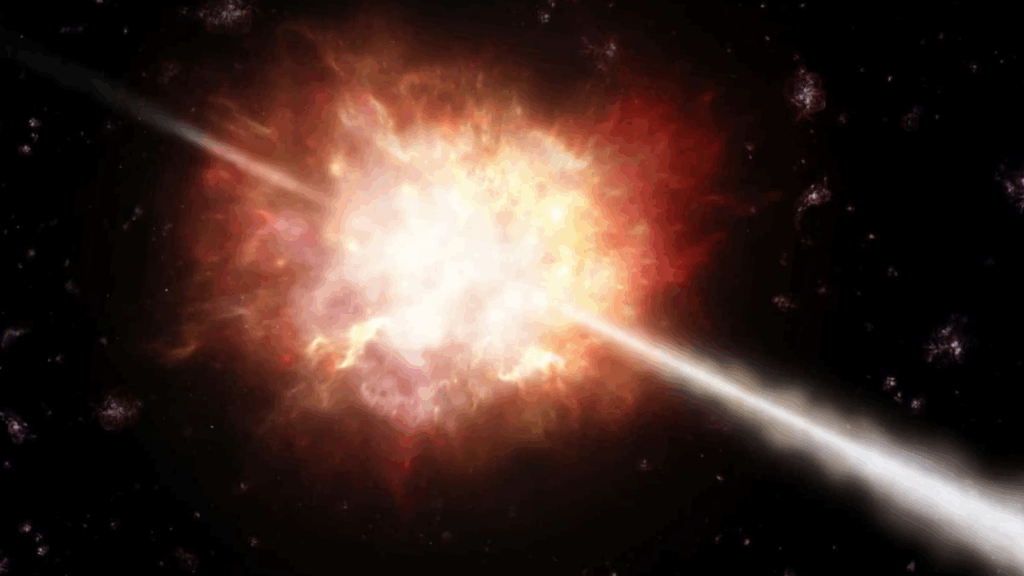
When space telescopes detected a blaze of high-energy radiation lasting for hours earlier this year, astronomers realized they were witnessing an extraordinary event. The cosmic flash, designated GRB 250702B, was not just any gamma-ray burst—it was the longest-lasting one ever recorded, persisting for nearly seven hours. This unprecedented duration has prompted scientists to reconsider their understanding of these powerful cosmic phenomena.
Gamma-ray bursts (GRBs) are among the universe’s most cataclysmic events, typically fading within minutes or even seconds. However, GRB 250702B surpassed all previous records, outlasting the former record-holder, GRB 111209A, by nearly three hours. This remarkable occurrence has compelled scientists to revise the textbooks on how such cosmic fireworks originate.
A Burst Unlike Any Other
The event first manifested on July 2, 2025, when NASA’s Fermi Gamma-ray Burst Monitor detected unusual signals lasting over three hours. Subsequent confirmations from other observatories, including the Konus-Wind detector, Japan’s Einstein Probe, and the Psyche-GRNS instrument, indicated a single source for the prolonged emission.
By analyzing data from the InterPlanetary Network, researchers reconstructed the event’s complete profile, recording a duration of approximately 25,000 seconds, or about seven hours.
“We see a hard spectrum, subsecond variability, and high total energy, which are only known to come from ultrarelativistic jets powered by a millisecond-stable stellar-mass central engine,” the study authors noted.
This was not the kind of explosion typically associated with a “collapsar,” where a giant star forms a black hole. The evidence defied existing models and hypotheses.
Finding the Source
An international team of over 50 astrophysicists explored various possibilities to explain GRB 250702B. Could it be a magnetar flare, a neutron-star merger, or a supermassive black hole at a galaxy’s center? Each hypothesis was systematically ruled out.
The energy levels were too high for a magnetar or binary merger, and the timescale exceeded what collapsars could provide. Furthermore, the event’s location, away from its host galaxy’s nucleus, eliminated the possibility of an active galactic nucleus. The remaining explanation was a rare and violent cosmic interaction known as a helium-merger event—a black hole colliding with the helium core of a companion star.
The Helium Merger Model
This model involves two massive stars orbiting each other until one collapses into a black hole. As the other star expands, the black hole moves towards its center, becoming trapped within the expanding stellar envelope. The resulting friction tightens the orbit until the black hole penetrates the star’s helium core.
At this stage, a powerful accretion disk forms around the black hole, propelling material inward and ejecting twin jets at nearly the speed of light. These jets, lasting tens of thousands of seconds, produce the gamma rays observed from Earth. The study authors explained,
“The angular momentum taken out of the orbit is transferred to the helium star, and as the black hole is making its way to the center of the core, the high angular momentum will propel the helium core to accrete through a disk.”
This process generates enormous energy, resulting in an explosion that can rival or even outlast a supernova.
Testing the Theory
Simulations of black holes with masses around two solar masses and helium stars between 32 and 60 solar masses replicated the light curves observed in GRB 250702B. The Blandford–Znajek process, which extracts energy from a spinning black hole, matched the burst’s steady rise and gradual decline in intensity.
Even minute details, such as shifts in photon energy and sub-second flickering, aligned with observations from Fermi’s NaI and BGO detectors. These findings, along with extended detections by MAXI and Psyche-GRNS, confirmed that the prolonged emission originated from a single continuous event.
The Supernova That Wasn’t
Following the initial burst, astronomers revisited the James Webb Space Telescope, expecting to find an incandescent supernova at the explosion site 25 days later. However, they found nothing—no afterglow or characteristic transient light.
This absence may actually support the helium-merger hypothesis. Simulations suggest that once a black hole reaches five solar masses, conditions in the accretion disk inhibit the formation of nickel-56, the radioactive isotope that illuminates supernovae. Any follow-up explosion would have been too weak to overcome the host galaxy’s dusty light.
The Team Behind the Discovery
This groundbreaking discovery was made possible through international collaboration. Eliza Neights led the background fitting and spectral analysis of the Fermi GBM data. Eric Burns coordinated the collaboration and assessed the event’s energy budget. Chris Fryer conducted helium-merger physics simulations, while Dmitry Svinkin analyzed Konus-Wind data to compare GRB 250702B with previous gamma-ray bursts.
The study was supported by NASA, the United States–Israel Binational Science Foundation, and international partners who provided pre-publication data for an expedited review of the results.
A New Window Into the Cosmos
The detection of GRB 250702B opens a new chapter in high-energy astronomy. It offers the strongest evidence yet that some ultra-long gamma-ray bursts result from black hole mergers with massive stars, rather than the collapse of individual stars.
This insight reshapes our understanding of stellar death, jet formation, and even gravitational-wave sources. The merger of a black hole with a star could potentially link two previously independent phenomena—gamma-ray bursts and the spacetime ripples detected by observatories like LIGO and Virgo.
Future missions, such as the Legacy Survey of Space and Time by the Vera Rubin Observatory and the upcoming Compton Spectrometer and Imager, will enhance the detection of these exotic cosmic events. With improved coverage and extended observation times, scientists anticipate observing more ultra-long GRBs and unraveling the life histories of the stars that fuel them.
Practical Implications of the Research
Decoding GRB 250702B not only sets a new record but also enhances our understanding of black hole formation and binary star system evolution. Such discoveries could refine models of supernova explosions and improve predictions of gravitational-wave signals, enabling scientists to pinpoint the origins of colossal cosmic collisions.
By linking GRBs with black-hole mergers, researchers move closer to mapping how elements, radiation, and even the building blocks of life are distributed throughout the universe. The research findings are available online in the journal arXiv.
Related Stories
- Astronomers capture first-ever image of two black holes orbiting each other
- Black hole stars: Giant stars may hide black holes at their core
- A wormhole from another universe? Scientists revisit the puzzling black hole GW190521
Like these kinds of feel-good stories? Get The Brighter Side of News’ newsletter.




